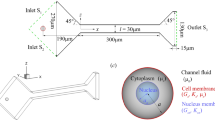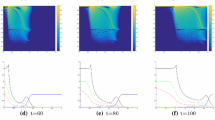Abstract.
The growth of a tumour in a rigid walled cylindrical duct is examined in order to model the initial stages of tumour cell expansion in ductal carcinoma in situ (DCIS) of the breast. A nutrient-limited growth model is formulated, in which cell movement is described by a Stokes flow constitutive relation. The effects on the shape of the tumour boundary of the material properties (i.e. the viscosity) and the extent to which the cells adhere to the duct wall are studied using numerical and asymptotic methods. It is shown how stable, non-planar, interface configurations result and that, during these initial stages, before the duct wall has been breached, few cells die and a nutrient-rich model is usually sufficient to capture the behaviour. Finally, we discuss the relevance of this approach to DCIS and suggest possible avenues for further work.
Similar content being viewed by others
References
Batchelor, G.K.: An introduction to fluid mechanics. Cambridge University Press, Cambridge, 1967
Breward, C.J.W., Byrne, H.M., Lewis, C.E.: Modelling the interactions between tumour cells and a blood vessel in a microenvironment within a vascular tumour. Eur. J. Appl. Math. 12, 529–556 (2001)
Brummer, O., Athar, S., Riethdorf, L., Loning, T., Herbst, H.: Matrix-metalloproteinases 1, 2 and 3 and their tissue inhibitors 1 and 2 in benign and malignant breast lesions: an in situ hybridization study. Int. J. Path. 435, 566–573 (1999)
Byrne, H.M.: The importance of intercellular adhesion in the development of carcinomas. IMA J. Math. Appl. Med. Biol. 14, 305–323 (1997)
Byrne, H.M., Chaplain, M.A.J.: Growth of nonnecrotic tumors in the presence and absence of inhibitors. Math. Biosci. 130, 151–181 (1995)
Byrne, H.M., Chaplain, M.A.J.: Growth of necrotic tumors in the presence and absence of inhibitors. Math. Biosci. 135, 187–216 (1996)
Byrne, H.M., Chaplain, M.A.J.: Modelling the role of cell-cell adhesion in the growth and development of carcinomas. Math. Comput. Model. 24, 1–17 (1996)
Byrne, H.M., King, J.R., McElwain, D.L.S., Preziosi, L.: A two-phase model of solid tumour growth. Appl. Math. Lett. In press
Chaplain, M.A.J., Sleeman, B.D.: Modelling the growth of solid tumours and incorporating a method for their classification using nonlinear elasticity theory. J. Math. Biol. 31, 431–473 (1992)
Engels, K., Fox, S.B., Whitehouse, R.M., Gatter, K.C., Harris, A.L.: Distinct angiogenic patterns are associated with high-grade in situ ductal carcinomas of the breast. J. Path. 181, 207–212 (1997)
Fernandez-Gonzalez, R., Jones, A., Garcia-Rodriguez, E., Chen, P.Y., Indica, A., Lockett, S.J., Barcellos-Hoff, M.H., Ortiz de Solorzano, C.: System for combined three-dimensional morphological and molecular analysis of thick tissue specimens. Microsc. Res. Techniq. 59, 522–530 (2002)
Franks, S.J.: Mathematical modelling of tumour growth and stability. PhD Thesis, 2001
Greenspan, H.P.: Models for the growth of a solid tumor by diffusion. Stud. Appl. Math. 51, 317–340 (1972)
Greenspan, H.P.: On the growth and stability of cell cultures and solid tumors. J. Theo. Biol. 56, 229–242 (1976)
Hanby, A.M., Millis, R.R., Oberman, H.A.: Diagnostic surgical pathology. Lippincott Williams and Wilkins, Philadelphia, 1999
King, J.R., Franks, S.J.: Mathematical analysis of some multi-dimensional tissue-growth models. Submitted, 2002
Landman, K.A., Please, C.P.: Tumour dynamics and necrosis: surface tension and stability. IMA J. Math. Appl. Med. Biol. 18, 131–158 (2001)
Moore, J.V.: Death of cells and necrosis in tumours: Perspectives in Mammalian Cell Death. Oxford University Press, Oxford, 1987
Morton, K.W., Mayers, D.F.: Numerical solution of partial differential equations. Cambridge University Press, Cambridge, 1994
Mueller-Klieser, W.F., Sutherland, R.M.: Oxygen-tensions in multicell spheroids of 2 cell-lines. Br. J. Cancer 45, 256–264 (1982)
Please, C.P., Pettet, G.J., McElwain, D.L.S.: Avascular tumour dynamics and necrosis. Math. Mod. Meth. Appl. Sci. 9, 569–579 (1999)
Ward, J.P., King, J.R.: Mathematical modelling of avascular-tumour growth. IMA J. Math. Appl. Med. Biol. 14, 39–69 (1997)
Author information
Authors and Affiliations
Corresponding author
Additional information
Send offprint requests to: S.J. Franks at Centre of Mathematical Medicine.
Rights and permissions
About this article
Cite this article
Franks, S., Byrne, H., King, J. et al. Modelling the early growth of ductal carcinoma in situ of the breast. J. Math. Biol. 47, 424–452 (2003). https://doi.org/10.1007/s00285-003-0214-x
Received:
Revised:
Published:
Issue Date:
DOI: https://doi.org/10.1007/s00285-003-0214-x




